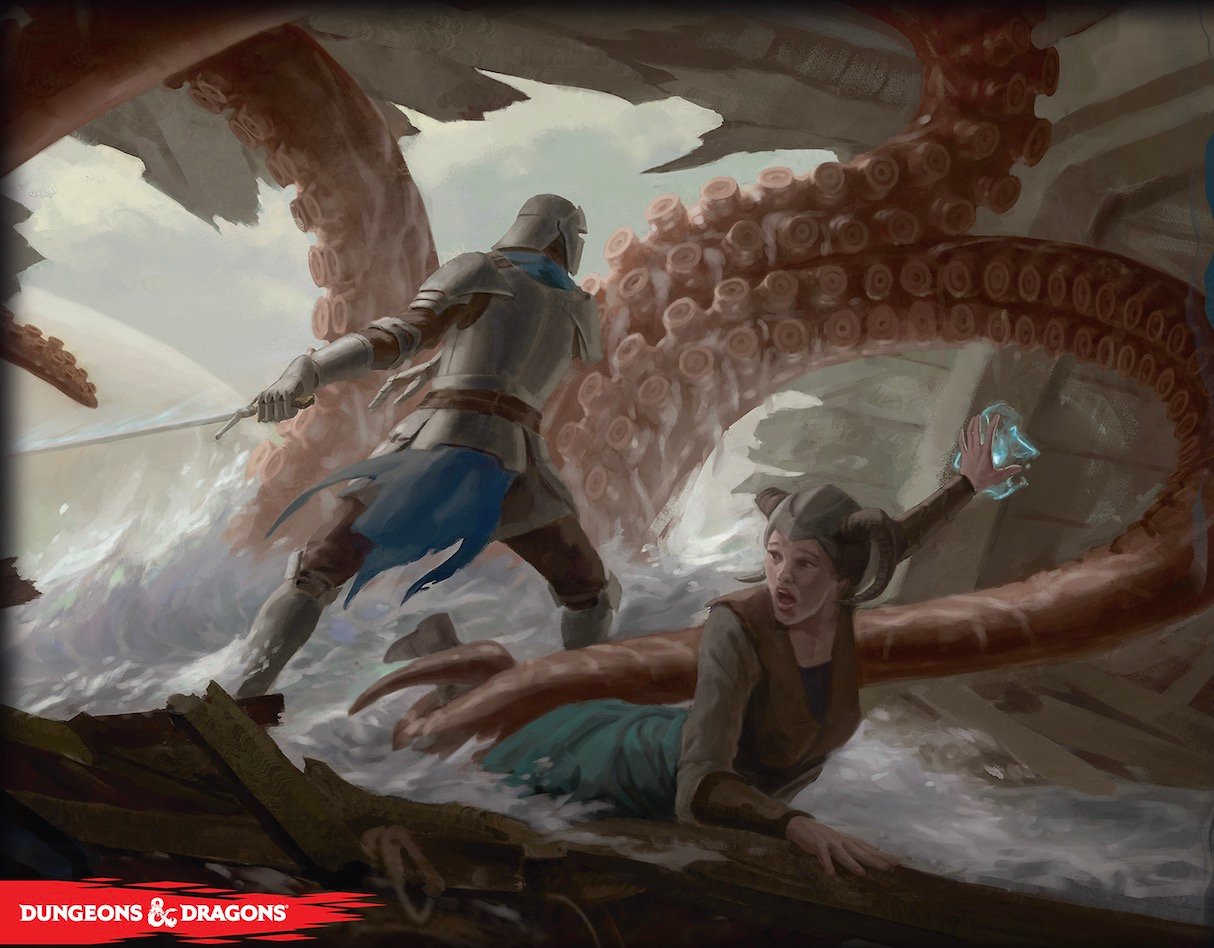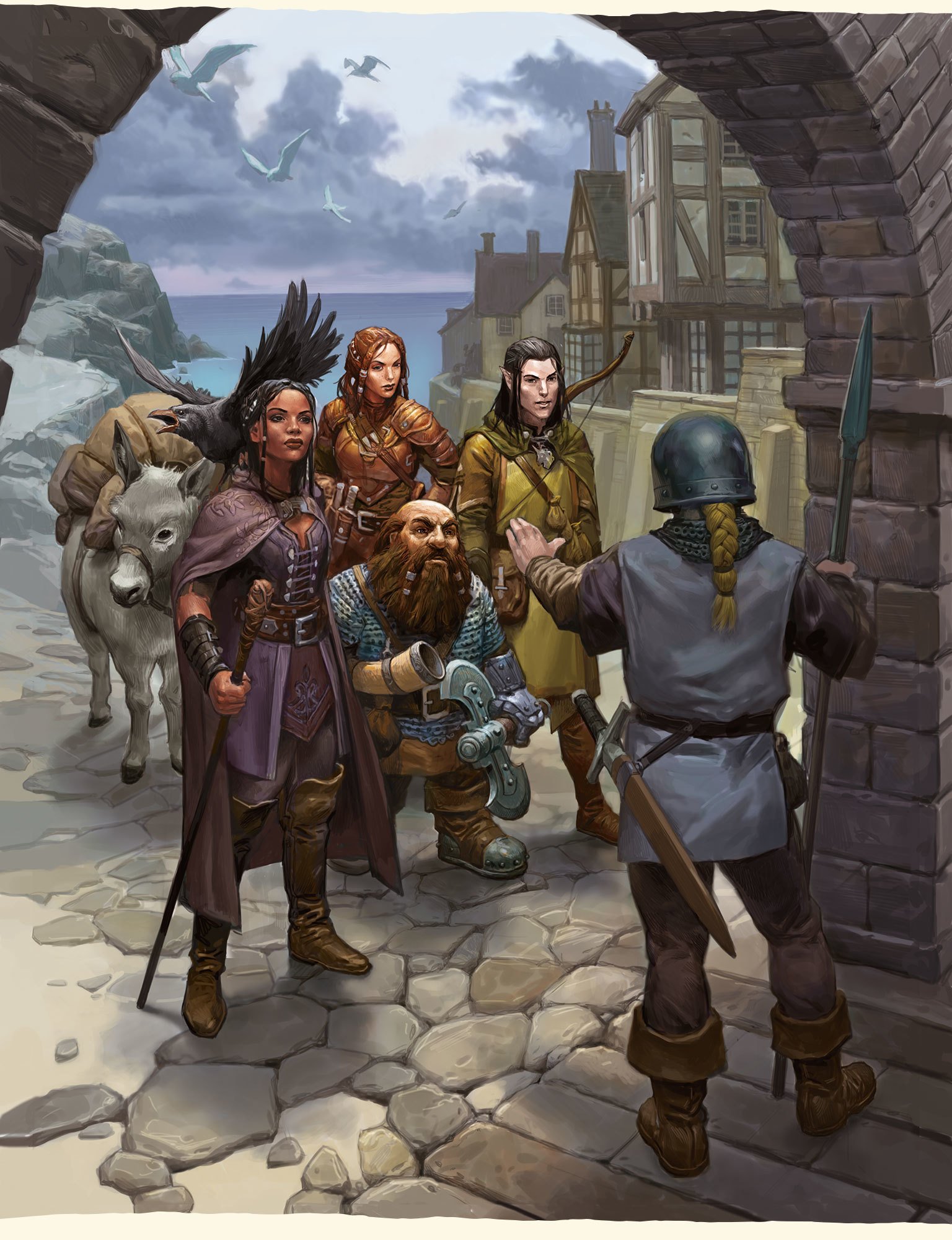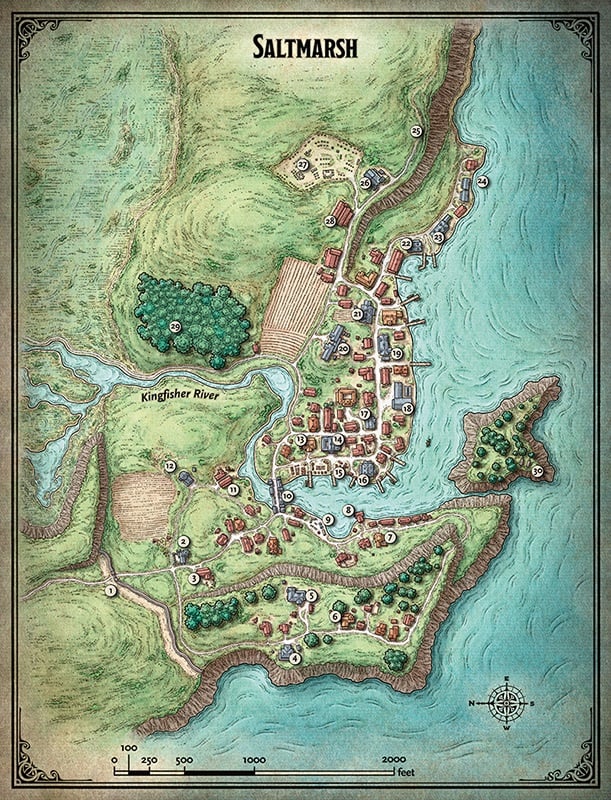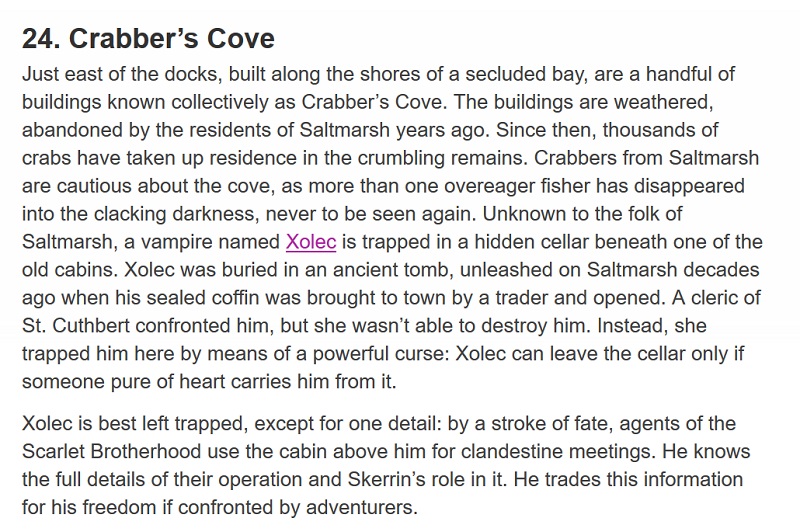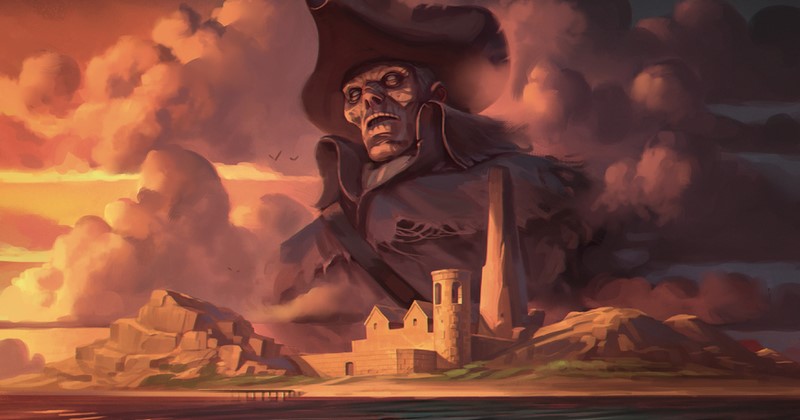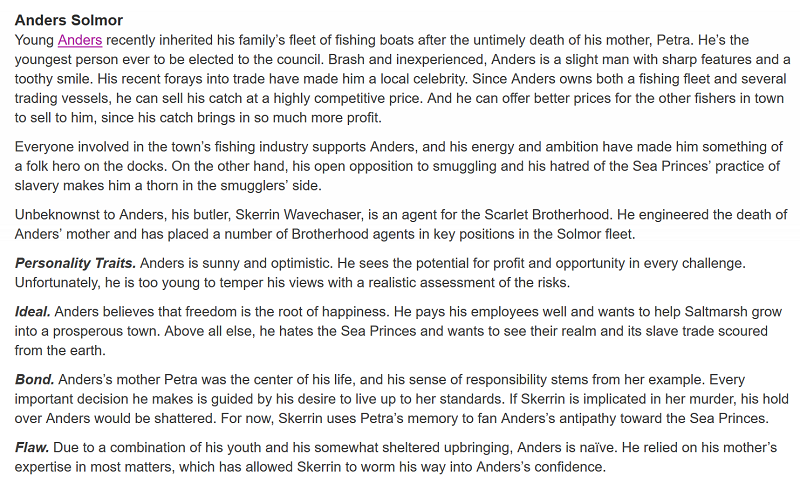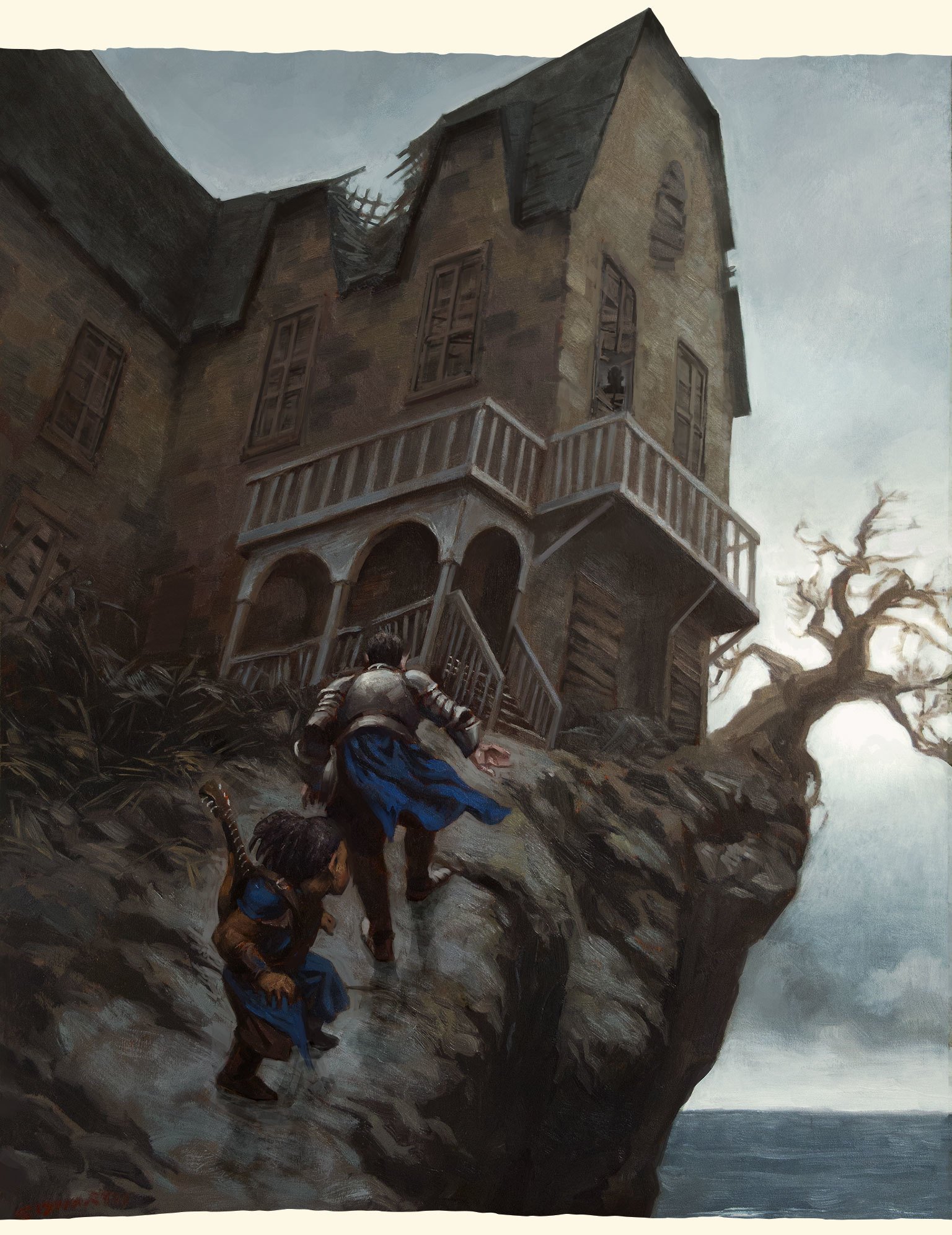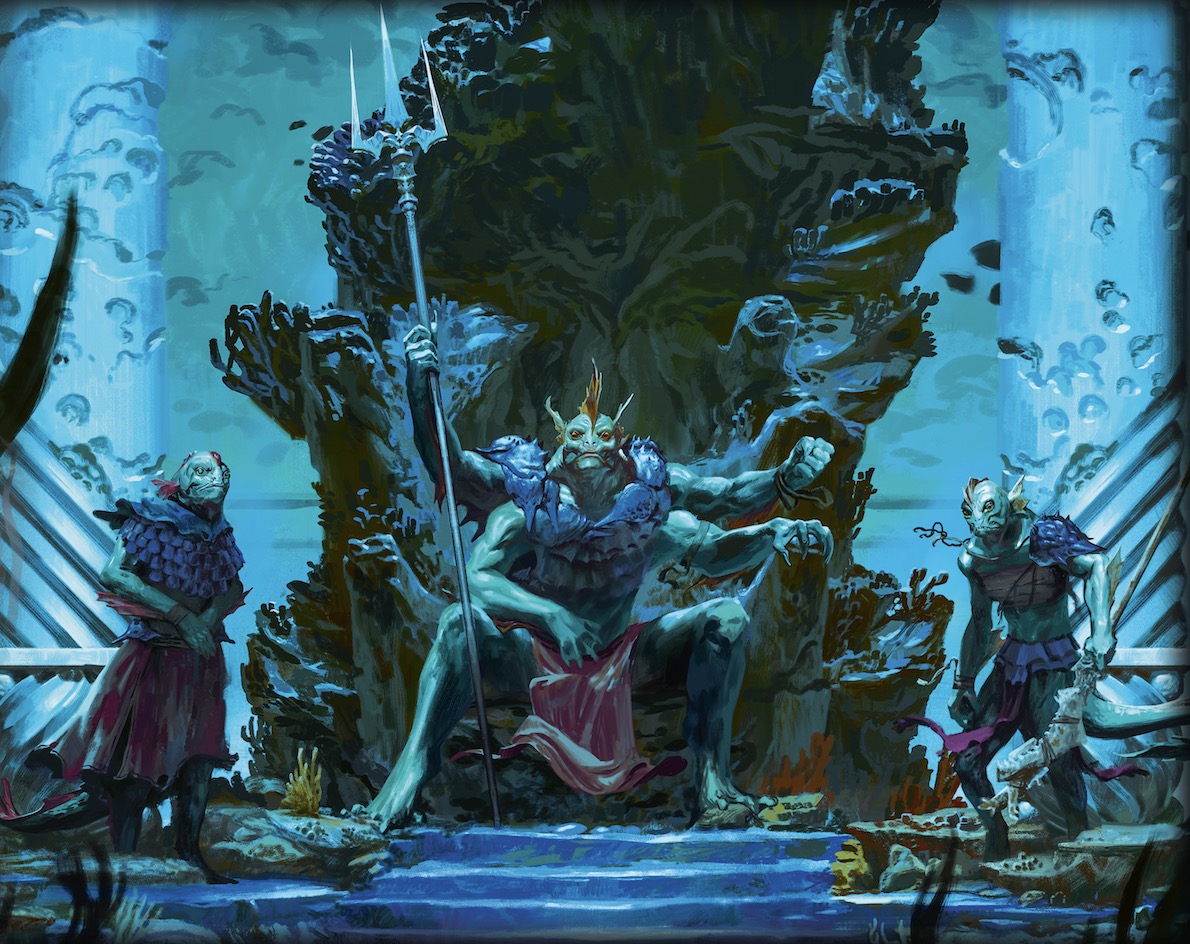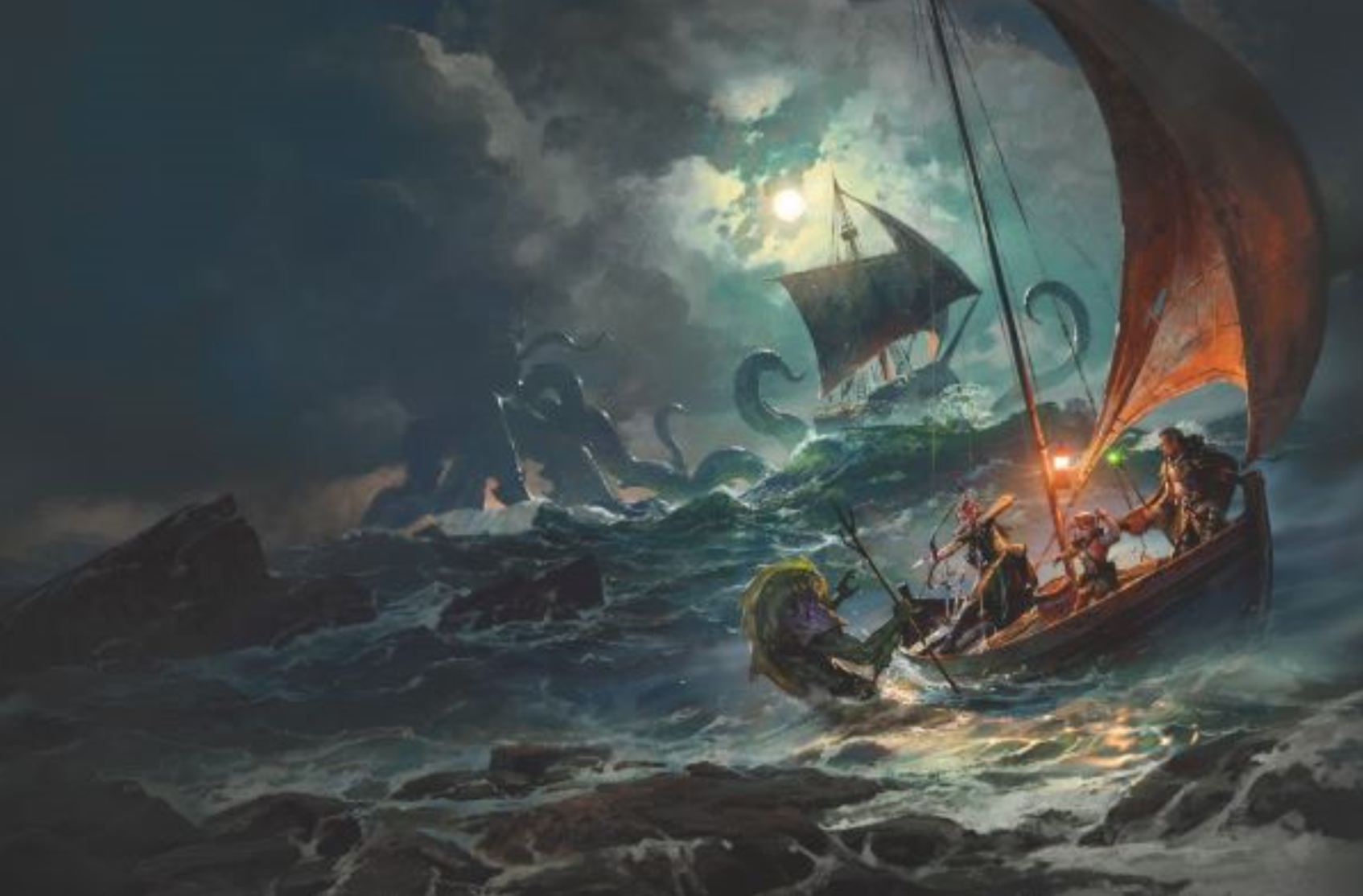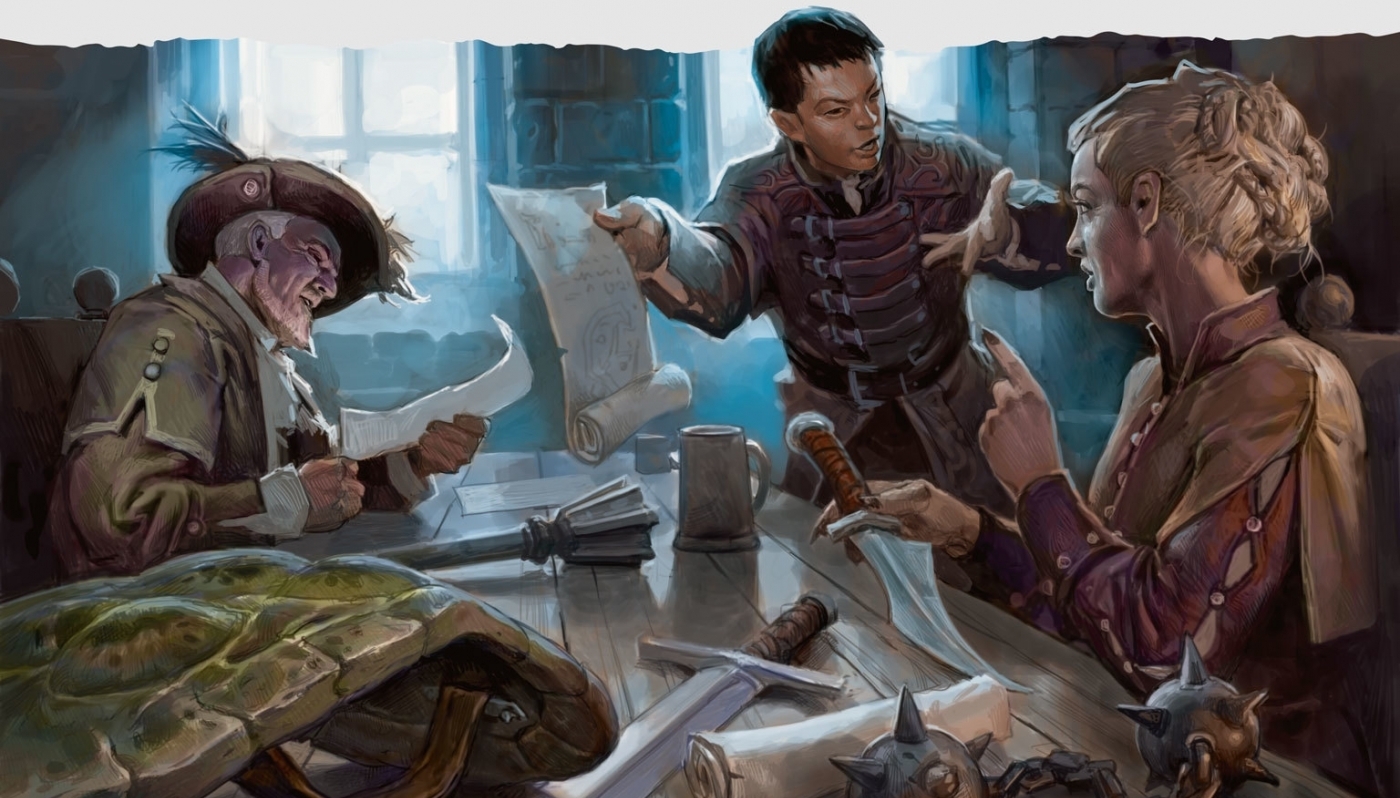D&D: Ghosts Of Saltmarsh – The BoLS Review
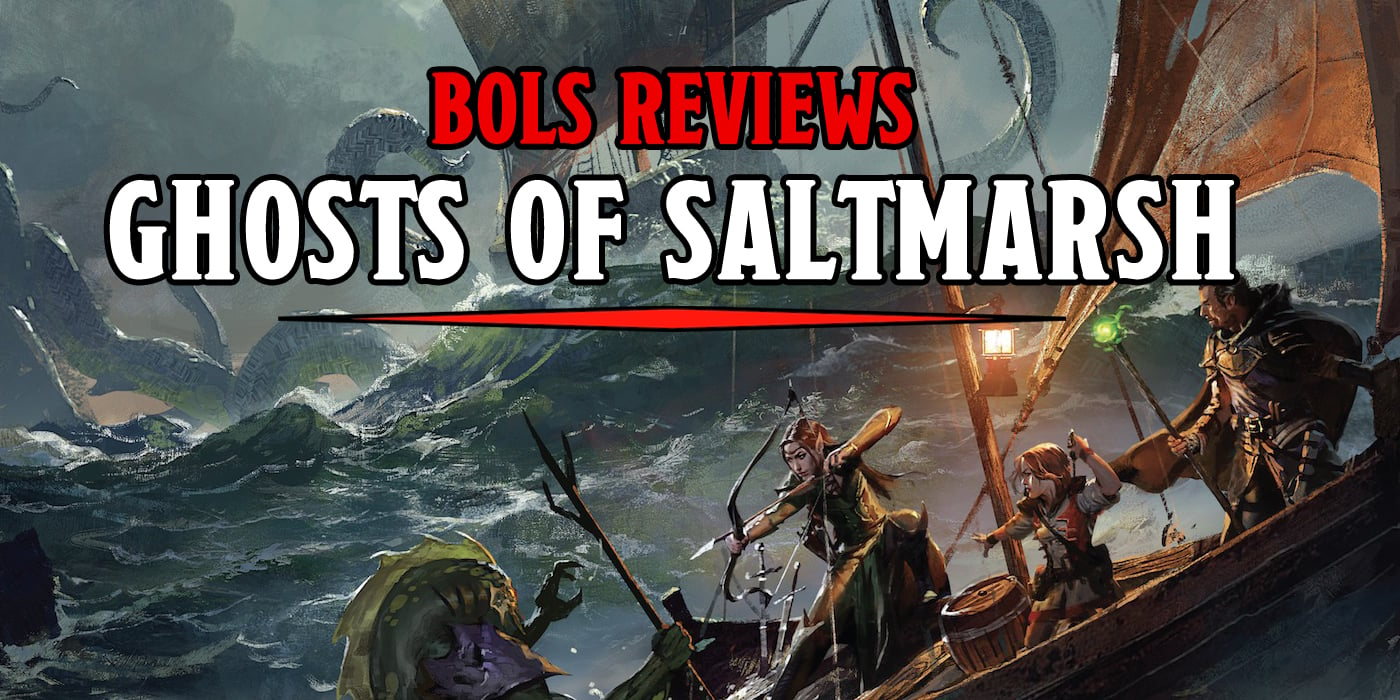

Ghosts of Saltmarsh is here at last, bringing with it seven adventures, three new factions, a town full of adventure, and a bunch of rules for maritime mayhem.
Ghosts of Saltmarsh is the brand-new book for D&D. Similar to Tales from the Yawning Portal, Saltmarsh brings another seven adventures out of D&D’s past editions and updates them for 5th Edition. And it would be easy enough to say that if you liked Yawning Portal you’ll like Saltmarsh and that would be true. And it would also be doing Ghosts of Saltmarsh one hell of a disservice. This book is excellent.
Mind you, it’s hard to review an RPG book, especially one like this that isn’t just a single campaign–though it can be that. In fact it can be many things. It casts a Vitruvian net in that it seeks not just to convey these adventures, but to understand what makes them tick, how they fit together. It is a study in proportion. In the architecture of what makes a good D&D book. Saltmarsh has a deceptively simple answer–it comes down to two things: character, and story.
The book is full of both, and we’ll get into that in a minute. But it’s not enough to just have vivid characters and rich stories upon which to hang these interactions. Ghosts of Saltmarsh isn’t just about running adventures, it’s about running a game. It’s about finding inspiration and laying out groundwork so strongly that it, at times, feels like you’re there. Saltmarsh is a book that wants you to use it, that makes itself easy to use. Or not use, as you see fit.
This balance of story, character, and ease-of-use is no small feat. This is Lead Designer Kate Welch’s first big title with WotC–as was revealed in a Spoilers and Swag months ago, this is the book she was assigned when starting at D&D, and you can really feel it. Before working at Wizards, Welch was a UI/UX designer working on titles like Amazon Games’ Crucible and Arena Net’s Guild Wars and Guild Wars 2. And you can really feel the difference in this book. It’s not something you’d normally think about–or even something you might notice because it’s an almost invisible part of the way the book is presented.
But everything about Saltmarsh feels like it’s put together to give the person reading it what they need. Whether you’re a veteran DM like me, who can find inspiration wherever it is, or a newbie to D&D who’s just stretching out their roleplaying legs–there’s something here for everyone to enjoy. First of all, the book is a heckin’ great read. Now part of that is that the town is small so ironically there’s more room for more specific details. You’re trying to say more about less and that helps bring it to life.
It’s not just that, though. Saltmarsh invites adventure. Seriously. Whether it’s reading through the three factions that compete for dominance (and for wildly different reasons), or looking through the different locations, you can feel the town coming to life. And I don’t think it’s just me. Reading the book lights you up with possibilities–and it does so with elegant little flourishes. Here’s a couple of samples. Spoilers ahoy.
First up is a location taken from the map of Saltmarsh. Crabber’s cove–on the map it’s marked by just a few houses. As near as I can tell, you might never go there in your game. But it’s got an interesting seed. It ties back to one of the three main factions competing for dominance of Saltmarsh, the Scarlet Brotherhood, and it’s a great hook to give players an interesting decision. The whole town is written up with how the player’s might interact with it in mind. It’s refreshing. As a seasoned DM, you can just jump right in and find a thousand different ideas leaping out at you.
As a newer player, you can find a town that feels so alive you remember the characters’ names even after just flipping through the book. And the characters in Ghosts of Saltmarsh are a huge part of why it’s so much fun to read through and where all those sparky, let’s-go-run-a-game feelings come from. The town, and associated adventures are full of characters. It’s a big part of the ethos of what made the first Saltmarsh series of modules so distinct. They were all about the character of the town.
Ghosts of Saltmarsh refines that idea. It presents you characters that are often at odds with themselves, or within the factions. Nothing is neat and tidy and that makes them interesting. Maybe it’s just seeing something besides the Forgotten Realms get some vibrant detail and attention, but it feels like there’s more here. Take the three main factions–we’ve been dancing around these enough. There are the Traditionalists, who are the townsfolk that just want life to go on as it has been. Saltmarsh ain’t broke, and they’re awfully tired of folks trying to fix it. Then there’s the Loyalists, who serve the King of Keoland (a meddling outsider or protector of the town, depending on whom you ask), and just want to see law and order reign. Then there’s the Scarlet Brotherhood, a secretive cult that’s bent on sowing chaos wherever they go, so that one day, their chosen rulers, the heirs of an ancient, long-dead dynasty, can rule.
Nothing terribly new about any of these factions, they don’t reinvent the wheel. Even the name, Scarlet Brotherhood, exists in World of Warcraft–but they are so richly detailed that I could tell you exactly how to run encounters with any of those factions without even having to flip back through the book. And a huge part of that comes down to the characters that represent each of the factions. For the Traditionalists, it’s a pair of staunch and important people in the town. You have a member of the town council who just wants to see her town succeed the way it has–and whose counterpart is an opportunistic dandy who appears foppish but is secretly making a profit running illicit smuggling operations, another Saltmarsh tradition.
On the Loyalist side, you get a former soldier who is used to fighting the wild things of the area, who is cautious and sees the influence of treacherous forces everywhere (and rightly so). Paired with him, a dwarven businesswoman who has been chosen to oversee new mining operations in town. Finally with the Scarlet Brotherhood we have a young noble:
And his evil butler who is secretly manipulating events in Saltmarsh to promote his liege into an unwitting puppet.
And if you’re wondering what makes this all pop so beautifully, it’s the tension in all of the characters. They have very simple wants that drive them to make deep and complex decisions. You have an easy sense of the characters and the conflicts that drive them. The Loyalists’ infighting and goals are easily mapped to their leaders, the Scarlet Brotherhood’s cunning is exemplified in its representative NPCs.
The whole town, heck, the whole region that Saltmarsh is in feels this way. It captures the best parts of D&D and examines them with a different lens. At every corner there are the usual random tables to prompt encounters–but even these are designed with the user in mind. You’ll find adventure hooks, and in a few cases, maps and sample encounters. Adventure is always just around the corner from whatever you’re reading.
It’s written with the idea that you’ll use any or all of it. Nothing feels wasted here, and nothing feels like it’s a dead end. Sure, not everything feeds into each other–but again, this is great. It shouldn’t. When we play D&D we want the world to feel real, even if it is designed to cater to the players’ every whims. We don’t want to see that catering–but it’s all there just beneath the surface. The town of Saltmarsh feels like a living breathing place that any DM can just pick up and start running.
Even if you’re the sort of DM who prefers to make their own characters up, it’s hard not to be swept away by how delightful or devious or larger-than-life many of these characters are. They’re not just there to facilitate the plot, they’re there to be enjoyed. Take Krag, the Half-Orc undertaker/town historian and loremaster, or the Apparatus of Kwalish-centric Captain Xendros, a tiefling magic item broker and evil priest of Iuz who has been sent to the town to make money and advance Iuz’ cause. But nothing she does is outwardly evil. She just sells magic items that let her detect the thoughts of anyone attuned to them (secretly, of course).
There’s all this wonderful tension and secret motivation that the players might never pick up on. But it informs everything about the place for a DM. It makes it easier to run, it gives you toys to play with. You can feel the delight behind each and every one of the NPCs. But you can especially feel it in my favorite section of the book, the writeup of the Region of Saltmarsh.
It’s just 8 pages long, but it’s full of so much inspiration. The Region loosely outlines where the seven adventures of Ghosts of Saltmarsh take place. But it also gives you extra detail about the world beyond those adventures. You might read up on Burle, a fortified outpost that stands guard against the Dreadwood (a scary forest overrun by monsters and the Shadowfell), and is home to an ancient treant ambassador as well as a cadre of soldiers who stand watch against horrors, aberrations, and outsiders creeping in from that haunted forest. Or perhaps you’ll learn about the Tower of Zenopus, a ruined wizards’ tower that has been bombarded into rubble, leaving only the mysterious depths of its lower levels open to smugglers and those brave enough to venture into the deeper levels.
You might learn about the Drowned Forest, home to an abyssal incursion that has slowly corrupted the forest and left it home to all manner of oddities. In its writeup you’ll find a list of weird and spooky features of the forest that invoke the darkness of it. There are high-level threats lurking at the heart of some lower level areas.
Again, it’s all about that tension. And all about how players and DMs can use the book. I was especially pleased to see the Background section detail not just how to theme the backgrounds to make them nautical–but how to specifically tie your characters to Saltmarsh. If you’re a local, they’ve got a guide to being a local, including characters you know. But they also give you roleplaying hooks. The new Smuggler background has stories of daring exploits, maybe you once smuggled contraband in the belly of a dead whale to sneak past authorities–or as a Marine you might once have completed a feat of physical endurance that has made you something of a local legend.
Whatever you choose, wherever you look, you’ll find stories that this book wants to help you tell. Saltmarsh grabs you and says, let’s play. And then it gives you some easy-to-use instructions to do it. Want to run the seven adventures in the book as a single campaign? Complete with side-quests? You can! You can find a campaign that will take players from level 1 to about level 11 if you only did what is in the book. It’s pretty ingenious, each adventure takes you almost to where you need to be to take on the next. A little exploring and RP around the town or its surrounding areas can help push you over the top.
That’s built-in pacing folks. I can’t say enough good things about this book. Every adventure has a faithful adaptation. We’ll be taking a much more in-depth look at them one by one in another article(s), but for now, let me say every adventure featured doesn’t just recreate the adventure with updated monsters. The authors who worked on each of these have done a great job of understanding what makes each adventure fun, what makes them challenging, and bringing that into 5th Edition.
There are some changes to these modules… but I think they’re changes for the better. The adventures feel a little more polished, and like they’re meant to fit together. The book even tells you how to string these adventures together with the adventures out of Tales from the Yawning Portal. And all that’s barely touching on the aquatic adventure rules that have their own suite of random tables meant to get your juices flowing. You might find magical storms, cursed islands, hostile islands–you don’t just get rules for running ships and fighting with them. You get rules for exploring the seven seas. For encountering unknown phenomena and feeling like you really are living in a legend about the sea. And another few modules’ worth of adventures in an appendix. An appendix.
Every module has guidelines for taking the adventure and running with it–if that floats your boat–or for moving on smoothly but with a sense that your actions have made a difference. Again, it’s that UX design at play here.
Ghosts of Saltmarsh feels a little different from the other books WotC has put out. It’s one I can’t wait to sink my teeth into a little more in the coming weeks. But for now, if you’ve been thinking about picking it up–BoLS definitely recommends it. You won’t find many others quite like it. It’s definitely more for DMs than players, but it’s a great resource to have on hand.
Happy Adventuring folks!

